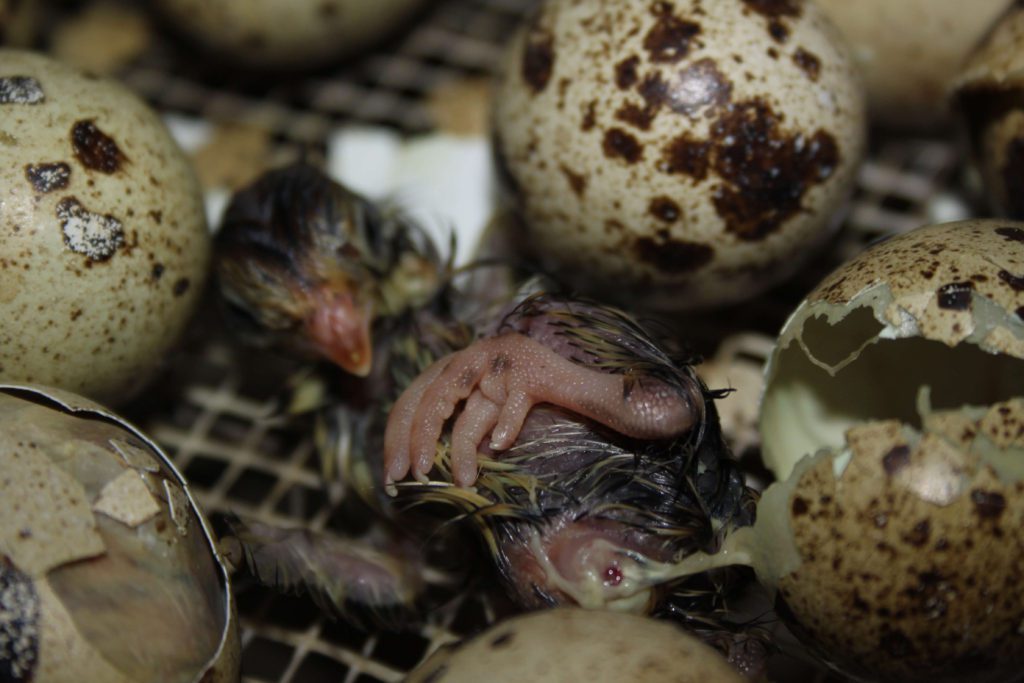There are many variables that can impact your quail hatch rate. Below is a list of common hatching issues that can result in a less than desirable hatch rate.
You can easily see that there are many variables (even more than listed below). Unfortunately, the majority of these factors are not within the control of the breeder. Many more factors are controllable by the hatching egg customer before and during incubation, however there are still some variables that are not within your control, primarily handling during shipment.
Hatching Egg Fertility
Breeder fertility is essential to a successful hatch.
- Jumbo coturnix quail will never have a 100% fertility rate, so you can always expect that a small percentage of eggs will be unfertilized
- With proper breeder management, fertility rates above 95% can be achieved.
- At Sandy Soil Farms, our quail are reviewed for egg fertility, prior to moving into our breeder program
- Our hatching egg fertility rates are regularly inspected from all current quail breeders. Only hatching eggs from breeder quail that produce eggs with a 95% or better fertility rate are sold and shipped to our customers as hatching eggs
- Remember that fertility rates cannot be inspected once the egg has begun incubation and just because an egg did not develop, does not necessarily mean it was not fertile
- Embryos that show no sign of developing are primarily caused by shipping vibration/jostling or inaccurate incubator temperatures
Genetics of the Parent Quail Flock
Genetic and hereditary issues can negatively impact your hatch rate
- Sandy Soil Farms Jumbo Coturnix quail flock began with very strong and selectively bred stock
- We continue to selectively breed our quail for the best bloodlines, genetic diversity, and to provide the largest, healthiest quail
Age of Hatching Eggs
Coturnix Quail hatching eggs can be viable past 14 days, however there are significant decreases in hatch rates past 14 days and lesser decreases beyond 10 days
- At Sandy Soil Farms, we only ship hatching eggs that are less than 72 hours old and ship USPS priority mail (1-3) days
- This provides ample shipping time and ensures that you receive quail hatching eggs less than 10 days old despite any unforeseen shipping delays
Shipping/Handling of Shipped Eggs
One of the largest variables and cause for low hatch rates
- The shipping process can cause distress and damage to hatching eggs
- Variables include:
- Obvious damage to eggs – Broken, dented, cracked eggs
- Egg damage that is not visible on the exterior of egg – Jostling, vibration, rough handling
- Significant Temperature fluctuations – Extreme heat or cold (usually happens at the shipping location)
- Prolonged high temperatures during shipping can cause incubation to begin
- Due to the impact of shipping on hatch rates, shipped egg hatch rates typically range from 45%-60%.
- Although hatch rates of 80%-90% have been reported to us from our customers, they are not as common
Rest Period for Shipped Eggs
24 hour period for shipped quail hatching eggs to reconstitute and acclimate to room temperature (pointy end down), prior to incubation
This process is critical for shipped eggs and shouldn’t be skipped or shortened
Incubation Temperature
This is one of the most common and overlooked causes for low quail hatch rates
- Consistent and accurate Incubation temperature is critical for a good hatch rate
- High temperatures in incubator can kill and embryo before it even starts developing
- Low temperatures in incubator can delay development and cause death inside the shell
- Temperature swings, hot/cold spots in incubator, or even the amount of airflow can cause low hatch rates
- Validating that the incubator temperature is accurate is essential and often overlooked by many folks, especially with consumer grade incubators
- Remember that your incubator heater will run hot until the temperature has stabilized throughout the incubator. Ensure the incubator has stabilized temperature prior to placing hatching eggs in it
Incubation Humidity
Accurate and balanced humidity during the incubation and hatching period is essential for chick survival and hatching
- High humidity levels can cause the chicks to run out of oxygen for the air sac
- High humidity levels can cause the membrane to become sticky, preventing the chick from moving inside the egg to hatch
- Low humidity levels can cause an early hatch
- Prolonged Low humidity or rapid decreases in humidity can cause the membrane to shrink and lock your quail chicks inside the egg, unable to hatch
Egg Turning
Egg turning is essential to prevent the embryo from sticking to a side of the shell
- Hatching eggs should be turned 3-4 times daily from day 1-15 of the incubation period
- Eggs should not be turned after day 15 (Lockdown)
Contamination
Contamination of embryos is a common cause of low quail hatch rates
- Clean and sanitize all parts of your incubator setup, prior to placing your hatching eggs in the incubator
- Wash your hands thoroughly before handling your hatching eggs and work in a clean area
Summary
In summary, incubation and successful hatch rates are not always as simple as we would like to think. There are many variables that are difficult to control and make diagnosing the cause of low hatch rates difficult.
However, with proper attention to the variables that are within your control, you can improve your hatch success with every hatch. It’s a marathon, rather than a sprint and you can gradually improve your hatches over time by following a methodical process.
